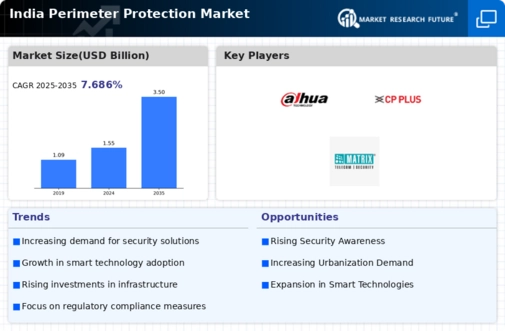Increasing Urbanization
The rapid urbanization in India is a crucial driver for the perimeter protection market. As cities expand, the need for enhanced security measures becomes paramount. Urban areas are witnessing a surge in population density, leading to increased crime rates and security threats. Consequently, businesses and residential complexes are investing in perimeter protection solutions to safeguard their properties. According to recent data, urban areas in India are expected to grow by over 30% by 2030, which will likely escalate the demand for advanced security systems. This trend indicates a significant opportunity for companies operating in the perimeter protection market, as they can cater to the growing need for effective security solutions in densely populated regions.
Rising Infrastructure Development
India's ongoing infrastructure development projects are significantly influencing the perimeter protection market. With the government investing heavily in transportation, energy, and urban infrastructure, the need for robust security measures around these projects is becoming increasingly evident. For instance, the construction of new highways, airports, and smart cities necessitates the implementation of perimeter security systems to protect assets and ensure safety. The Indian government has allocated approximately $1 trillion for infrastructure development in the coming years, which is expected to drive the demand for perimeter protection solutions. This investment not only enhances security but also promotes economic growth, thereby creating a favorable environment for the perimeter protection market.
Regulatory Compliance and Standards
The establishment of regulatory compliance and security standards is a significant driver for the perimeter protection market. In India, various sectors, including banking, healthcare, and manufacturing, are subject to stringent security regulations. Organizations are required to implement effective perimeter protection measures to comply with these regulations, which drives demand for security solutions. For instance, the Reserve Bank of India mandates specific security protocols for financial institutions, compelling them to invest in perimeter security systems. This regulatory landscape not only ensures safety but also creates a robust market for perimeter protection solutions, as companies strive to meet compliance requirements while safeguarding their assets.
Growing Threat of Terrorism and Crime
The increasing threat of terrorism and crime in India is a critical driver for the perimeter protection market. High-profile incidents have heightened awareness regarding security vulnerabilities, prompting both public and private sectors to prioritize perimeter security. The government has recognized the need for enhanced security measures, leading to increased funding for security initiatives. Reports indicate that the crime rate in urban areas has risen by approximately 20% in recent years, underscoring the urgency for effective perimeter protection solutions. As organizations seek to mitigate risks and protect their assets, the perimeter protection market is expected to grow, driven by the pressing need for comprehensive security strategies.
Technological Integration in Security Systems
The integration of advanced technologies in security systems is reshaping the perimeter protection market. Innovations such as artificial intelligence, machine learning, and IoT are being increasingly adopted to enhance security measures. These technologies enable real-time monitoring, threat detection, and automated responses, which are essential for effective perimeter protection. In India, the market for smart security solutions is projected to grow at a CAGR of 15% over the next five years. This growth indicates a shift towards more sophisticated security systems that can adapt to evolving threats. As businesses and institutions recognize the value of technology in enhancing security, the perimeter protection market is likely to experience substantial growth.














Leave a Comment